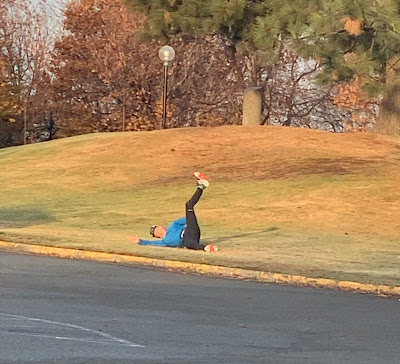Running Resolutions for 2022
 |
| The upper of Nike's Space Hippie 04 includes 75% of recycled material, by weight, from recycled bottles, t-shirts, and yarn scraps |
January is the perfect time for the runner to take stock of the previous year and where their running is headed for the current year. For me, I’ve decided to make some slight changes to where I’m headed with my running in 2022:
Explore Building Running Fitness with “Cruise Intervals”
It seems like after each Olympics interest grows in how the best in the world train and race to find a new “secret running sauce” that can be added to training. The recent Tokyo Olympics was no exception: what are the Ingebrigtsen brothers of Norway doing in their training? For those who may not know, there are three brothers in the Ingebrigtsen family who have gone on to each become European distance champions. And, at Tokyo, the youngest brother, Jakob, went on to win the 1500m gold medal. An Ingebrigtsen “secret sauce workout” seems to be similar to cruise intervals – think tempo run with short rest intervals included - developed by running coach, Jack Daniels. This year I’ll check out how cruise intervals impact my running fitness.
 |
| Jakob Ingebrigtsen (centre) on his way to winning the 1500m gold medal |
Explore Using Concurrent Endurance and Strength Training
The idea of concurrent training - combining endurance and strength training one after the other in a single session – is appealing to me. Aerobic training, especially running, leaves the body in a catabolic state (muscle breakdown); whereas, strength training leaves the body in an anabolic state (muscle building). What happens when these two types of training are brought together? If one goes by previous research, faster running can happen from concurrent training which is worthy of exploration.
 |
| Side Leg Raises and this Lunge Matrix are part of this runner's concurrent training program |
Take Steps Toward “Greener” Running
When it comes to counteracting the effects of climate change, I’ve looked to governments and corporations to make the move. However, this year I want to focus on what small steps I can take to lower my carbon footprint when it comes to running. For instance, at one in-person race, due to Covid restrictions actually, organizers didn’t have cups of water available to runners at aid stations. Instead, entire bottles of water were being given out! With this information beforehand, I decided to pack my own water and not use aid station resources - something I haven’t ever done before in a race. Was this change awful for me? No! And in a small way probably saved some material going to the landfill. This year I’m interested in exploring what small changes, like the example above, a runner can make to reduce the carbon footprint.
 |
| This moisture-wicking t-shirt from Brooks is made with 88% recycled materials |
* * * * *
Have a question on a topic you’d like to see covered on Experiment Of One Coaching this year? Or have some tips for me being a greener runner? Email me at info@experiment1coaching.com .
Readers interested in checking out my running resolutions from the previous three years can go to these links: 2019 / 2020 / 2021
Cruise intervals are run at a “comfortably hard” pace of a tempo run with short rest intervals included. For comparison, readers can check out my previous posts on tempo running and running coach, Jack Daniels: Monthly Run Challenge: Tempo Run and Trying to Master the "Elusive" Tempo Run
Implementing concurrent training has led to a re-think on muscle strengthening. Yet, after reading an article on strength training I wrote in 2018, I’ve got to admit that the ideas in this article still make sense when it comes to muscle strengthening for endurance athletes. Check out: Changing My Approach to Muscle Strengthening 2018
Thanks for reading!
QUESTION?
info@experiment1coaching.com
WEBSITE
Experiment of One Coaching covers topics ranging from running, strength training, health & wellness, sports nutrition to travel.
Comments